#jung semin
Explore tagged Tumblr posts
Text
Boys Be Brave official trailer for: main couple // second couple
from the director who did Our Dating Sim and producer of Move to Heaven premiere: April 25

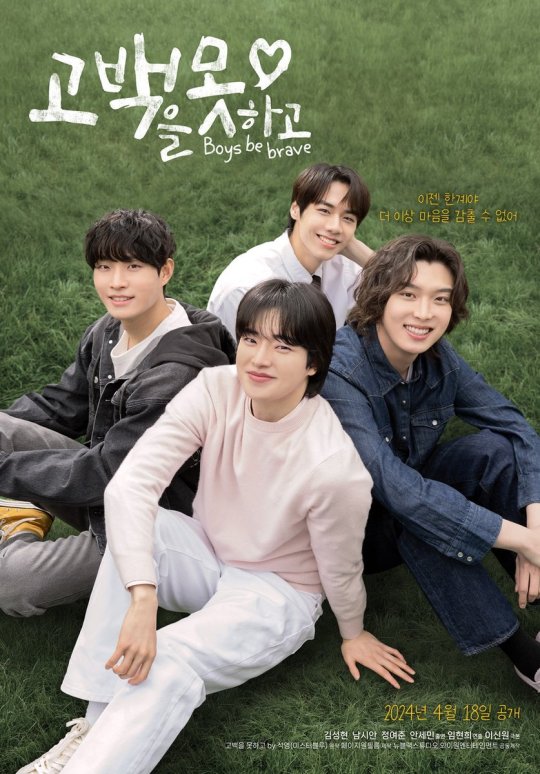

youtube
(1m22s) 02.04.24
#boys be brave#official trailer#kim sung hyun#kim sunghyun#nam shi an#nam shian#jung yeo jun#jung yeojun#ahn se min#ahn semin#blmpff
46 notes
·
View notes
Text
"inho likes balgeum more ..." "why???".
#PLEASE SEMIN IS SO ADORABLE WITH HIS LIL 🥺🥺🥺🥺.#anyway so many people have said this BUT. both their eyes are SO SOO SOOOOO expressive my god.#ahn semin#jung yeojoon#boys be brave
22 notes
·
View notes
Text
Meeting The Shadow: A Summary of Self-Discovery Insights
Chapter 1 What's Meeting The Shadow by Connie Zweig
"Meeting the Shadow: The Hidden Power of the Dark Side of Human Nature," edited by Connie Zweig and Jeremiah Abrams, is a seminal work exploring the concept of the shadow in psychology, particularly in the context of Jungian theory. The shadow represents the unconscious part of the personality that contains repressed weaknesses, desires, and instincts. The book comprises essays from various contributors addressing how acknowledging and integrating the shadow can lead to personal growth and transformation.
Through different lenses, the authors examine the importance of facing one's darker aspects to attain a more authentic and complete self. The process of "meeting the shadow" is portrayed as vital for healing and self-awareness, prompting readers to embark on a journey of introspection and exploration of their hidden selves. The work provides tools for understanding the impact of the shadow on relationships, creativity, and societal issues, ultimately advocating for a more balanced and integrated approach to personal development. The book also emphasizes the necessity of compassion and understanding towards both oneself and others in this transformative journey.
Chapter 2 Meeting The Shadow by Connie Zweig Summary
"Meeting the Shadow," edited by Connie Zweig and Jeremiah Abrams, is a collection of essays and writings that explore the concept of the "shadow" as articulated by Carl Jung, which represents the unconscious parts of ourselves that we repress or deny. The book delves into themes of self-discovery, personal growth, and the integration of these shadow aspects into our lives.
The contributors share their insights on how acknowledging and confronting the shadow can lead to greater self-awareness and emotional healing. The essays provide various perspectives on the shadow, including its impact on relationships, creativity, and societal dynamics. The work emphasizes that integrating the shadow is essential for achieving wholeness and authenticity.
Zweig and Abrams encourage readers to embrace their darker sides rather than shunning them, suggesting that this integration can lead to a more fulfilling and harmonious life. The book serves as both a practical guide and a philosophical exploration, aiming to help individuals understand and navigate their inner complexities.

Chapter 3 Meeting The Shadow Author
Connie Zweig is a prominent author and thought leader in the realms of psychology and spirituality. She is best known for her work on the shadow aspect of the psyche, exploring themes of personal growth and self-awareness.
"Meeting the Shadow: The Hidden Power of the Dark Side of Human Nature," which she co-edited with Jeremiah Abrams, was first published in 1991. This influential book compiles a range of essays by various contributors, focusing on the psychological concept of the "shadow"—the parts of ourselves that we repress or deny.
In addition to "Meeting the Shadow," Connie Zweig has authored several other notable works, including:
1. "Romancing the Shadow: A Guide to Soul Work for a Vital, Authentic Life" - This book elaborates on the theme of the shadow and provides practical guidance for integrating it into one’s life.
2. "The Inner Work of Age: Shifting from Role to Soul" – In this work, Zweig explores the inner challenges and opportunities that accompany aging, offering insights for personal development in later life.
3. "The Shadow & the Joy: A Guide to Creating a Life You Love" – This book focuses on embracing one's shadow to foster personal joy and fulfillment.
As for the "best" edition, it often depends on what a reader is looking for. The original edition of "Meeting the Shadow" remains a foundational text in psychological literature on the topic of the shadow, and the essays included have been influential in both psychological practice and personal development. Additionally, subsequent editions might include updated introductions or additional commentary, which can enhance the reading experience, so checking for the most recent edition might be advisable for new readers.
For anyone interested in Zweig's work, it would be helpful to read reviews or explore summaries to determine which book best meets their interests!
Chapter 4 Meeting The Shadow Meaning & Theme
Meeting The Shadow Meaning
"Meeting the Shadow" by Connie Zweig is a book that delves into the concept of the "shadow," a term popularized by psychologist Carl Jung. In Jungian psychology, the shadow represents the unconscious, repressed aspects of the self, including instincts, desires, and traits that an individual may perceive as negative or undesirable.
Zweig's work explores various dimensions of the shadow, encouraging readers to confront and integrate these hidden parts of themselves rather than deny or suppress them. The book emphasizes the importance of acknowledging and understanding the shadow to achieve personal growth, self-acceptance, and a more authentic life.
The meaning of "Meeting the Shadow" can be interpreted as a call to self-examination and healing. By recognizing and engaging with one's shadow, individuals can unlock deeper truths about themselves and foster healthier relationships with others. The process of integrating the shadow can lead to greater self-awareness, emotional resilience, and an expanded capacity for compassion—both for oneself and for others.
Overall, Zweig's exploration signifies a journey towards wholeness, suggesting that embracing all parts of oneself, even the darker aspects, is essential for personal development and psychological well-being.
Meeting The Shadow Theme
"Meeting the Shadow" by Connie Zweig explores the theme of the shadow self, a concept rooted in Jungian psychology. The shadow represents the unconscious parts of our psyche that we often deny, reject, or ignore. The book emphasizes the importance of acknowledging and integrating these hidden aspects of ourselves, as this process can lead to personal growth, healing, and a more authentic life.
Key themes include:
1. Self-Awareness and Integration: The importance of recognizing and confronting one's shadow to achieve self-knowledge and wholeness. By integrating these hidden parts, individuals can live more authentically.
2. Transformation and Healing: Emphasizing that facing the shadow can lead to profound transformations, allowing individuals to transform their pain into power and reclaim what has been disowned.
3. The Role of Acceptance: Highlighting the necessity of accepting all aspects of oneself, including the darker facets, to foster compassion for oneself and others.
4. Gender and Archetypes: Exploring how societal norms and expectations influence the development of one's shadow and how these dynamics play out across genders.
5. Personal and Collective Shadow: Addressing not only individual shadows but also collective ones, thereby inviting dialogue about cultural and societal shadow aspects.
Overall, "Meeting the Shadow" urges readers to embark on a journey of introspection and acceptance, promoting a deeper understanding of themselves and their relationships with others.

Chapter 5 Quotes of Meeting The Shadow
Meeting The Shadow quotes as follows:
"Meeting the Shadow" by Connie Zweig is a profound exploration of the shadow aspect of the psyche, drawing from Jungian psychology. While I can't provide exact quotes from the book, I can summarize key themes and ideas typical of the work:
1. Acknowledgment of the Shadow: Emphasizes the importance of recognizing the hidden parts of ourselves that we often deny or repress.
2. Integration of the Shadow: Discusses the necessity of integrating our shadow to achieve wholeness and personal growth.
3. Projection: Explains how individuals often project their shadow onto others, leading to conflicts and misunderstandings in relationships.
4. Healing Through Acceptance: Advocates for a compassionate approach to self-acceptance, suggesting that healing comes from embracing our flaws and darker aspects.
5. The Shadow in Relationships: Explores how unresolved shadow issues can manifest in romantic and interpersonal dynamics, leading to repeated patterns.
6. Cultural Shadows: Addresses how societal norms and cultural expectations shape individual shadows, influencing collective behavior.
7. Creative Expression: Encourages the use of art and creative outlets as a means to confront and express shadow aspects.
8. Jungian Concepts: Incorporates Carl Jung's ideas, such as the anima/animus and archetypes, in understanding the shadow.
9. Personal Responsibility: Highlights the need for individuals to take responsibility for their shadow aspects to foster personal development.
10. Path to Enlightenment: Suggests that confronting and integrating our shadow is essential for spiritual awakening and deeper self-awareness.
If you need more specific details or analysis on certain aspects of the book, let me know!
Chapter 6 Similar Books Like Meeting The Shadow
Sure! Here are five compelling book recommendations that delve into psychology, self-discovery, and the complexities of the human experience:
1. "The Body Keeps the Score" by Bessel van der Kolk
This groundbreaking book explores the profound impact of trauma on the body and mind. Van der Kolk, a leading expert on trauma, presents a wealth of research and case studies, describing how trauma can affect our physical health and emotional well-being. He also discusses various therapeutic approaches, including innovative treatments like EMDR and mindfulness, offering hope and guidance for healing.
2. "Man's Search for Meaning" by Viktor E. Frankl
A powerful memoir and psychological exploration, Frankl shares his experiences as a Holocaust survivor and the insights he gained about finding purpose in life, even under the direst circumstances. Through his concept of logotherapy, he emphasizes the importance of meaning, resilience, and the human spirit, making it a profound read for anyone seeking direction in their life.
3. "The Gifts of Imperfection" by Brené Brown
In this inspirational guide, Brené Brown encourages readers to embrace their imperfections and cultivate a sense of worthiness. Drawing on her research in shame and vulnerability, Brown outlines ten guideposts for wholehearted living, offering practical strategies to foster authenticity, courage, and connection in our lives.
4. "Emotional Intelligence" by Daniel Goleman
Goleman’s influential book reshapes the way we think about intelligence. He argues that emotional intelligence—our ability to understand and manage our own emotions as well as the emotions of others—is just as important as traditional cognitive intelligence. Through research and anecdotes, Goleman provides insights that are invaluable for personal and professional development.
5. "The Untethered Soul: The Journey Beyond Yourself" by Michael A. Singer
This enlightening book explores the nature of consciousness and the self, encouraging readers to detach from their inner negative dialogues and find deep inner peace. Singer's spiritual perspective offers practical advice on how to free oneself from habitual thoughts and emotions and live in the present moment, making it a thought-provoking read for those on a journey of self-discovery.
These books all offer profound insights into human psychology, self-acceptance, and the journey of personal growth, making them excellent choices for anyone looking to deepen their understanding of themselves and others.

Book https://www.bookey.app/book/meeting-the-shadow
Author https://www.bookey.app/book/meeting-the-shadow#Author
Quotes https://www.bookey.app/book/meeting-the-shadow/quote
The Power of Now https://www.bookey.app/book/the-power-of-now
Youtube https://www.youtube.com/watch?v=s8tKHZ4LHsg
Amazon https://www.amazon.com/Meeting-Shadow-Hidden-Power-Nature/dp/087477618X
Goodreads https://www.goodreads.com/book/show/182155.Meeting_the_Shadow
0 notes
Photo

Carl Jung’s concept of the Spirit of the Times reflects the collective mindset and cultural attitudes that dominate a particular era. It represents the intellectual and societal forces shaping how individuals think, act, and perceive the world. For Jung, this "spirit" often dictates norms and values, aligning people with the prevailing trends of their age. In his seminal work, The Red Book, Jung contrasts the Spirit of the Times with the Spirit of the Depths, the latter representing the timeless, universal truths rooted in the unconscious and archetypal realms. While the Spirit of the Times emphasizes conformity and external concerns, the Spirit of the Depths invites introspection and connection to the deeper, eternal aspects of the psyche. Jung saw the Spirit of the Times as necessary but potentially limiting. Over-identification with it can sever individuals from their inner selves, causing spiritual disconnection. His writings encourage a balance: to engage with the world while remaining attuned to the Spirit of the Depths
1 note
·
View note
Text
Reflection 9: Picasso's Minotaurmachy and the Jungian Approach
This seminal etching by a younger Picasso is a study in personal iconographic appropriation; it is often agreed upon by scholars that this print-series much informed the artist’s later ‘Guernica’, as well as other war-centred works, most notably in terms of symbolic and metaphoric imagery that he is well-known for. In regard to Picasso’s personal and/or biographical influences on this work, there is much speculation. It is generally agreed that the work was created during a turbulent and unstable period of his life (Moma, 2024), which was much informed by concerns relating to the outbreak of the Spanish Civil War in 1936, as well as the recent reveal of his mistress’s pregnancy (Marie-Thérèse Walter), causing even further divide and turmoil in his marriage to Olga Khokhlova. The work is a quintessential exemplar of the artist’s surrealist phase, doing much to break logical consistency and the laws of perspective, regardless of the mythological (and hints of religious) subject matter.
A busy scene acted out by a colourful cast of characters unfolds in a frenzy of sketchy, yet organized hatching. It is through this cast of characters by which the Jungain perspective may aid in analysing the work’s ambivalent meaning. Six or so figures (some blend into a jumble of limbs) of alternating age and gender are composed evenly across the page, presenting varying degrees of reminiscence to the company of archetypes that Jung suggested. It is important to note that the archetypes themselves are described by Jung as inherited, collective and - to some extent - culturally dependent inner psychic models or ideals (Kralingen, 2017). Thus, given the highly subjective nature of both the theory and the proposition (that every archetype is subject to each person’s inner psychology), it is inevitable that a highly interpretive approach is unavoidable.
For instance, what can be interpreted as the archetypal ‘mother’ makes her appearance in something resembling the Virgin with Mary Magdalene, who are typically pictured together in religious iconography, owing to their particular closeness within the holy family. This can be seen through the white dove perched at the fore, the primary figure’s veil, and the secondary figures lack thereof – a common way of representing both holy figures in partnership – and the rather elevated position of both, leaving them at the top of a triangular, hierarchical composition. Though Picasso was an avowed atheist, he made regular use of spiritual and traditional religious imagery, similar to Francis Bacon’s abundant use of the crucifixion. Picasso was especially wont to do this in relation to war-related thematic concerns, positioning the role of religion as an actor in the scenery.
Moreover, a minotaur of Ancient Greek mythology hulks over a large area of the work; this can be interpreted as the father, or the anima; an inner expression of masculinity in both sexes, according to Jung. This also coincides with the common usage of the bull as a symbol for masculinity, fecundity, and authority, especially in regard to Spain and its national associations with the imagery.
Other archetypes can be matched with the figures; the disembowled horse may well be the shadow, representing a turbulent and violent subconscious or repressed desire; the animus within the young girl, the female counterpart of the anima, which holds a beaming candle and seemingly threatens the minotaur; or perhaps the wise old man, observable on the immediate left trying to climb out of the painting may represent the departure of reason – a visual metaphor for taking leave of one’s wits. In any case, the work can be interpreted as an interesting, charged, and tense inner map of the psychological state of the artist, who would possibly also have been encouraged by the wave of popularism psycho-analysis attained in the early to mid-twentieth century.
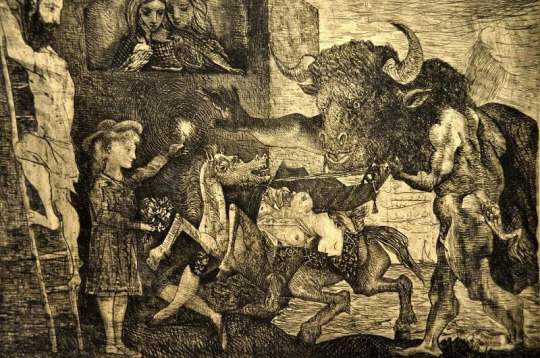
Adams, L. (2020). Art and Psychoanalysis. [online] obo. Available at: https://www.oxfordbibliographies.com/display/document/obo-9780199920105/obo-9780199920105-0030.xml.
Kralingen, A. van (2017). COMPLEX, ARCHETYPE, SYMBOL in the Psychology of C.G. Jung by Jolande Jacobi. [online] Appliedjung. Available at: https://appliedjung.com/complex-archetype-symbol/.
MoMA (n.d.). Pablo Picasso. Minotauromachy (La Minotauromachie). 1935 | MoMA. [online] The Museum of Modern Art. Available at: https://www.moma.org/collection/works/60110.
Museu Picasso (n.d.). Minotauromachy | Picasso museum Barcelona | Official website. [online] museupicassobcn.cat. Available at: https://museupicassobcn.cat/en/collection/artwork/minotauromachy [Accessed 22 Jan. 2024].
Princeton University (n.d.). La Minotauromachie (Minotauromachy) (x1986-104). [online] artmuseum.princeton.edu. Available at: https://artmuseum.princeton.edu/collections/objects/16133 [Accessed 16 Jan. 2024].
0 notes
Text
Listed: Arthur King
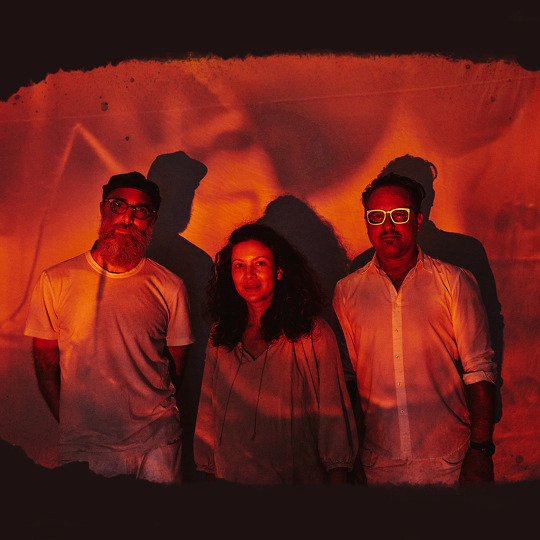
Arthur King is the creative alias of multidisciplinary artist Peter Walker, whose works span film, music, photography, painting, and sculpture. His latest album, Changing Landscapes, centers around a Latin American insect known as the Zompopa, or leaf-cutter ant, building improvised soundscapes over the tropical insect noises. In her review, Jennifer Kelly wrote, “Changing Landscapes (Zompopa) is, indeed, a deeply affecting listening experience, melding the twittering, chittering serenity of the tropical wild with angelic vocals (Mia Doi Todd in particularly lovely form), electronics and other instruments.“ Here Walker lists some books and films that have inspired him.
5 books:
The Spell of the Sensuous (David Abram)

This book is gorgeously insightful. He touches on the tenets of ecopsychology, which posits all things in the natural world as having a soul, the anima mundi. He suggests, as do countless other wise teachers, that all things are connected in an intricate webwork, and that our individual well-being is undoubtedly connected to the well-being of all things.
Pagan Grace (Ginette Paris)
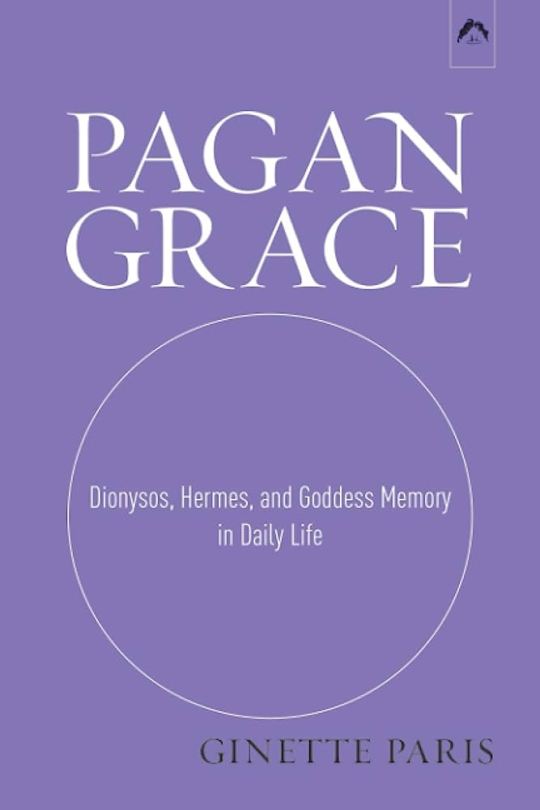
A mythological book with an in-depth psychological perspective. Basically, the gods of old can be seen as representing different parts of the psyche, because they were born from deep human needs that were otherwise unexplainable. Dionysus and Hermes are of particular interest to those dabbling in the creative arts. Paris was also one of my favorite professors in grad school.
Memories, Dreams, Reflections (C.G. Jung)
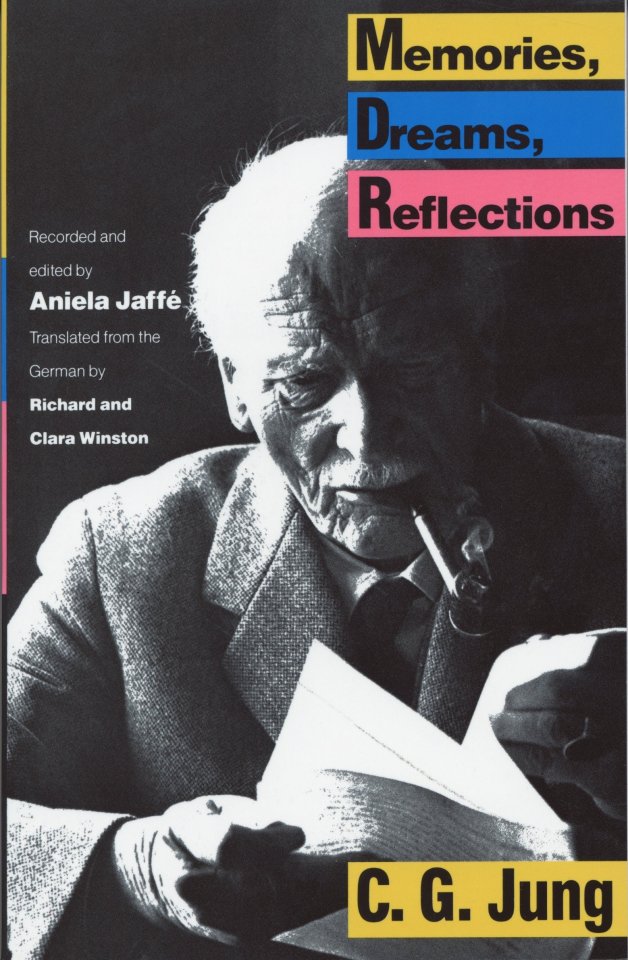
In this insightful memoir, Jung writes about a listening exercise he did in his home, basically active listening, when the sounds he heard, once he became still, filled the air like a natural sort of symphony. With a little attention, the background became the foreground. Brian Eno later elaborated on this concept with his production of (and coining of the phrase) ambient music. Jung also reflects on his intensive engagement with his unconscious when he was middle aged, a process that took him more than a decade and ultimately produced his seminal The Red Book. That period of his life, he says, came to define all that happened before it and all that happened after it. He is an inspiration to dive deep.
Miles: The Autobiography (Miles Davis and Quincy Troupe)
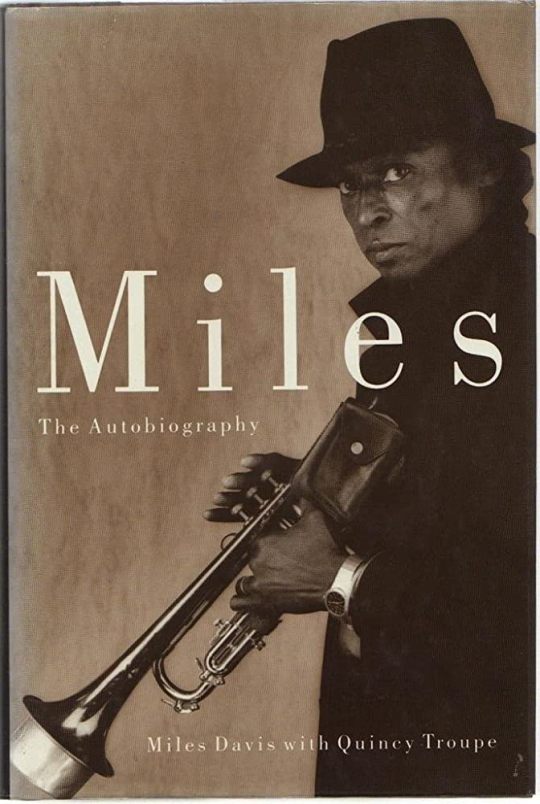
I’ve read more music biographies than I’d probably admit to, but this one is special. Released just a few years before Miles’ death, I read it in my early twenties and remember loving it. What a story he had! I’m still a huge fan, and am looking forward to re-reading this one when I have a nice long break from whatever else it is that I occupy my time with.
Dream and the Underworld (James Hillman)
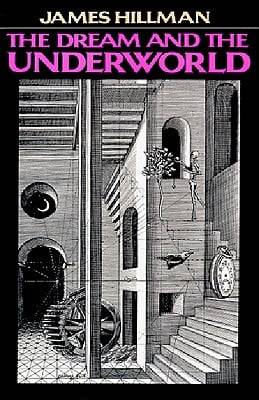
Hillman is just a force unto himself. The way his brain works is almost too hard to follow sometimes, the way he loves to turn phrases around on themselves to propose another viewpoint. One of my favorite concepts of his relates to the dream world, or the unconscious, and the task of trying to understand its contents. Hillman explains that in order to understand something irrational, we must irrationally understand, or more simply, try to move away from our logical, intellectual processes, and enter a more creative realm.
5 movies:
Three Thousand Years of Longing (d. George Miller)
youtube
I’m a big fan, it turns out, of recent George Miller movies. Mad Max: Fury Road being one of them. This latest film of his is wonderfully mythological, and the editing and sound design is a joy to experience. It’s also refreshing to see Middle Eastern/Muslim mythology at work.
The Red Turtle (d. Michaël Dudok de Wit)
youtube
We (Arthur King) have an ongoing live scoring event called “Unknown Movie Night,” where both the audience and band find out what film we’re scoring the moment it plays. The Red Turtle was the most recent selection, just a few weeks ago now. It’s a beautifully simple animated tale from the stupendous Studio Ghibli, and is both heart wrenching and eye opening. I can say this after watching the film, not listening to it! As far as I know, it has very little dialogue, so we all enjoyed this one, with its newly-minted improvised score, very much.
Children of Men (d. Alfonso Cuarón)
youtube
Another director-to-be-a-fan-of, this is a masterpiece by Cuarón, in my opinion. Easter eggs aplenty in this one — lots of ripe and symbolic imagery about the fall of humans. Maybe we won’t be too far off in the real-world 2027? The story is so rich and the film making is both otherworldly and familiar.
Hereditary(d. Ari Aster)
youtube
I don’t like horror films. I tend to avoid them. But this one is just so well done, it’s perhaps worth being scared out of your gourd for a little while. It’s the kind of psychological thrill ride that goes way beyond the jump scares and into a deeper realm of unfolding realities and supernatural phenomena. Maybe watch this one during the day, with other people around.
Inception (d. Christopher Nolan)
youtube
OK so maybe we’re ending with an easy one, but I needed it after just remembering Hereditary. I love the metaphors in this film associated with the different layers of one’s psyche. As we enter deeper and deeper into the subject’s mind, we find not only more irrationality, but also more barriers of entry. The last stronghold in this case, the deepest nook of the psyche, is pictured as a military-style fort in a secluded frozen land, armed to the nines and just about impossible to penetrate. Sound familiar?
#dusted magazine#listed#arthur king#peter walker#david abram#ginette paris#c.g. jung#miles davis#quincy troupe#james hillman#george miller#michaël dudok de wit#alfonso cuarón#ari aster#christopher nolan
1 note
·
View note
Photo







*∘✧ If you used, reblog or like ✧∘*
#kpop khh male#great guys#haneul#baekgyeol#daun#dongin#hwalchan#horyeong#jeong yeongki#kim jinhyeon#lee junghoon#lee youngjun#lee daeyeong#jung semin
4 notes
·
View notes
Photo




baekgyeol ❀ girls like you
#baekgyeol#semin#jung semin#greatguys#ultkpop#*m: gif#handsome boy !!!!#literally this cover is so nice i love them sm
12 notes
·
View notes
Text
Happy Birthday to Great Guy’s Baekgyeol!

GREAT GUYS - BAEKGYEOL Do not edit or crop logo! Do not share without full cr: On picture.
#GREATGUYS#GREAT GUYS#GREATGUYS BAEKGYEOL#GREAT GUYS BAEKGYEOL#BAEKGYEOL#JUNG SEMIN#TONGUESOFKPOP#TONGUES OF KPOP#KPOP#K-POP#K-POP GREAT GUYS
8 notes
·
View notes
Text
Boys Be Brave official poster

main couple // second couple
26.03.24
35 notes
·
View notes
Text
oh the behind the scenes? is even more adorable :(((.
#THEIR CHEMISTRY!!! THEIR EYES!!! THEIR EYES ARE SO SO EXPRESSIVE MAN.#ahn semin#jung yeojoon#boys be brave#faiza talks
20 notes
·
View notes
Video
youtube
I know BTS just had their comeback, but please also check out the comeback of GREATGUYS. They’ve worked so hard and the song is really fun!!!
#greatguys#kpop#great guys#멋진녀석들#im hahyeong#jeong yeongki#kim jinhyeon#lee junghoon#kim donghyun#lee youngjun#lee daeyoung#jeon mingi#jung semin
2 notes
·
View notes
Quote
nesne arzunun gerisindedir.
jacques lacan - kaygı semineri, 1962
#Jacques Lacan#kaygı#anksiyete#seminer#psikoloji#psikea#psikanaliz#literary#library#Alfred Adler#blogger#Sigmund Freud#carl jung#totem ve tabu#adam phillips#kuramsal#yabancılaşma#trend#okuma notları#seminerler#kitap#kitap kurdu#kitaplık#martin heidegger#Jean Paul Sartre#varklık ve zaman#varlık ve hiçlik#felsefe#felsefi fragmanlar#frederick nietzsche
17 notes
·
View notes
Photo

@isikelci RÜYA KOÇLUĞU NEDİR? Eğitimi tamamlayanlar, bireysel rüya seansı ve rüyalar üzerine seminer verebilecek yeterlilikte olurlar. RÜYA KOÇLUĞU; Rüyaların analizi yapıldıktan sonra tespit edilen durumlar bilinçalti şifa çalışmaları ile çözümlenir. Böylece blokojlar ortadan kalkar. Kişi yaşamın tüm kaynaklarında pozitif sonuçlar almaya başlar, rüyalarının kalitesi artar. Uyku ve uyanık yaşam birlik içinde olur. Seans sonrası motivasyon artırıcı ödevler verilir. Program kapsamında etkin 3 özel teknik öğrenerek çözümlemeleri yapabileceksiniz. 🌷🦋 Bu eğitim de rüyalar ruhsal ve bilimsel olarak bütüncül şekilde ele alınırken, uyku süresini nasıl şifaya dönüstürmemiz gerektiğine dair pek çok teknik öğrenecek ve rahatlıkla uygulayabileceksiniz. Bu eğitime arzu ederseniz ONLINE olarak katılabilirsiniz. #seminer #ruyakoclugu #rüyalarınızı #rüyaanalizi #rüyayorumu #rüyagünlügü #rehberrüyalar #jung #rüyalarindili - #regrann https://www.instagram.com/p/CFg5b38Jzrn/?igshid=1llijtdx2t48a
#seminer#ruyakoclugu#rüyalarınızı#rüyaanalizi#rüyayorumu#rüyagünlügü#rehberrüyalar#jung#rüyalarindili#regrann
0 notes
Text

I first saw Daniel Henney 16 years ago as the 2nd lead in a KDrama called “My Name is Kim Sam Soon”.
A seminal kdrama for me and my drama fan journey that has lasted nearly half of my life. I adored the main four actors/characters in that drama so much that I actually later bought the physical DVD copy of the drama...in 2006. Let’s just say, it was hella expensive on my broke ass college student budget. I was real poor back then.
Then he was in “Seducing Mr. Perfect” with K-cinema queen Uhm Jung Hwa and the chemistry was piping hot and it was a WRAP for me.

To watch him now absolutely CRUSHING it in a role playing one of my favorite fictional fantasy characters from a novel series I genuinely love despite its flaws...I could not be happier.
I am having a real fucking blast this winter.
I just keep rewatching the end of ep 5 in complete and utter awe of how moving it was.
#daniel henney#the wheel of time#wheel of time#lan mandragoran#my name is kim sam soon#kdrama#liveblogging
31 notes
·
View notes
Text
On the Essential Deconstruction of Belief
I’ve been pondering this morning my own approach to religion, which has been deeply informed both by academic inquiry and sustained practice in several contexts. Through it all, I would say there are really three seminal suppositions that, examined well, elucidate my own understanding of religion and I would argue inform a path forward for responsible religious engagement in the emerging post-postmodern world.
First, when it comes to religion the German philologist Max Müller rightly observed that “[they] who knows one, knows none”.
Our beliefs must fall apart under scrutiny, and the best scrutiny for deconstructing the seeds of irrationality and sycophancy are broad conversations and engagements with the religious experiences and practices of diverse peoples, cultures, and contexts. Specifically worth noting is the tendency for exclusionary revelation to take poisonous root in people’s hearts, under the banner of any manner of belief (details thereof quickly become irrelevant).
Next, once we have begun to deconstruct and examine tendencies toward the exclusionary supremacy of any belief structure, and indeed begun to root out belief itself for reasoned practice, we must come to understand what in fact a religion is, that is to say, it’s functional ontology.
The American anthropologist Clifford Geertz posited wisely that “a religion is a system of symbols which acts to establish powerful, pervasive, and long-lasting moods in [humans] by formulating conceptions of a general order of existence and clothing those conceptions with such an aura of factuality that the moods and motivations seem uniquely realistic”.
Finally, sobered by the elucidated fallacies of belief, and yet perhaps questioning what value religious practice may then yet hold, the British poet W. H. Auden reminds us that we are meaning making and story telling beings in saying “it is as meaningless to ask whether one believes or disbelieves in Aphrodite or Ares as to ask whether one believes in a character in a novel; one can only say that one finds them true or untrue to life. To believe in Aphrodite and Ares merely means that one believes that the poetic myths about them do justice to the forces of sex and aggression as human beings experience them in nature and in their own lives.”
Certainly from here we could bound substantially, touching other suppositions on the power of myth from the American scholar of comparative mythology Joseph Campbell, to the Swiss psychiatrist Carl Jung’s understandings of archetypal forms and the nature of mystical experience, to the advances into the neuroscience of dreaming and the unconscious generally from South African neuropsychoanalyst Mark Solms, and on, and on, and on.
Suffice it to say, religion is a perennial, inescapable, and serious matter. And, it is only responsibly, and most harmlessly engaged through a balanced lens of sincere practice and multidisciplinary, scholarly critique.
~Sunyananda

#zen#buddhism#buddha#buddhist#dharma#enlightenment#sangha#awakening#nirvana#spirituality#peace#religion#love#liberation#spiritual#joy#spirit#happiness#meditation#moksha#belief
12 notes
·
View notes